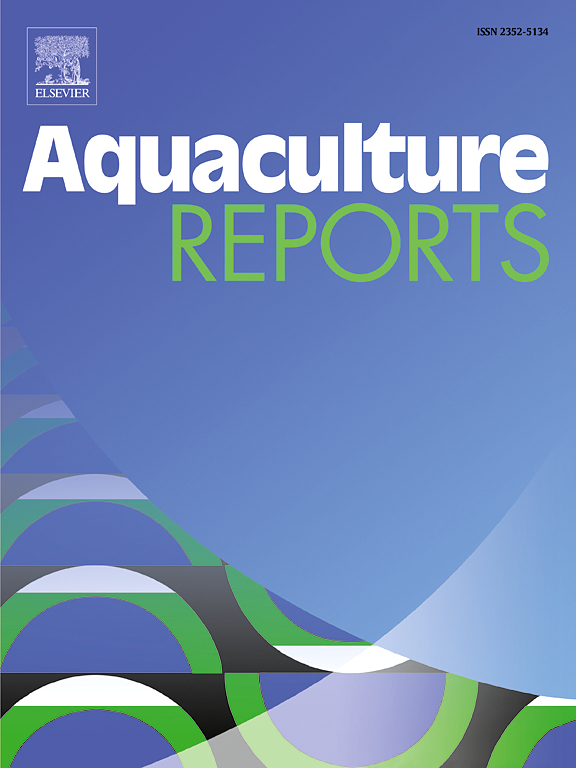In silico insights into the molecular mechanisms of Eclipta alba leaf fractions enhancing nonspecific immune mechanisms and resistance to Aeromonas hydrophila in Oreochromis mossambicus (Peters)
IF 3.2
2区 农林科学
Q1 FISHERIES
引用次数: 0
Abstract
The present study evaluated the impact of the water-soluble fraction (WSF) and hexane-soluble fraction (HSF) from Eclipta alba, a medicinal plant native to India, on nonspecific immune mechanisms and disease resistance in Oreochromis mossambicus (Mozambique tilapia) experimentally infected with Aeromonas hydrophila. Fish were intraperitoneally administered E. alba leaf fractions at doses of 0, 4, 40, or 400 mg kg−1. Immune parameters, including ROS and RNS production by leukocytes and serum lysozyme activity, were monitored at several time points (-2, 2, 4, 6, 8, and 10 days post-treatment). Both WSF and HSF significantly (p < 0.05) increased ROS levels across all days tested. The highest WSF dose (400 mg kg−1) notably induced RNS production (p < 0.05) on most days. Additionally, mid doses (40 mg kg−1) of both HSF and WSF significantly (p < 0.05) stimulated lysozyme activity on day 8. Disease resistance tests showed that the highest doses of HSF and WSF (400 mg kg−1), when administered as double doses, reduced mortality (p < 0.01) and increased relative percentage survival. These findings suggest that WSF and HSF fractions from E. alba, when administered at an optimal dose of 400 mg kg−1, stimulate the nonspecific immune mechanisms of O. mossambicus, improving resistance to A. hydrophila infection. Several compounds in the extracts were identified using GC-MS/MS, and their structures were retrieved. Molecular docking of the retrieved structures with NADPH oxidase (NOX) and Nitric oxide synthase (NOS), which are key enzymes involved in ROS and RNS production, was conducted using AutoDock software. Docking results showed that stigmasterol (WSF) and ethylcyclodocosane (HSF) bound to both NOX and NOS with high affinity. The observed immunostimulatory activity may be mediated through NOX and NOS activation, as supported by our in-silico docking studies.
黄花叶组分增强mossambicus非特异性免疫机制和对嗜水气单胞菌抗性的分子机制研究
本研究评估了印度原生药用植物赤藻水溶性部分(WSF)和己烷可溶性部分(HSF)对实验感染嗜水气单胞菌的莫桑比克罗非鱼(Oreochromis mossambicus)非特异性免疫机制和抗病性的影响。鱼被以0、4、40或400 mg kg−1的剂量腹腔注射白叶提取物。在几个时间点(治疗后2、2、4、6、8和10天)监测免疫参数,包括白细胞产生ROS和RNS以及血清溶菌酶活性。WSF和HSF均显著(p <; 0.05)提高了所有测试日的ROS水平。最高剂量(400 mg kg−1)在大多数时间显著诱导RNS产生(p <; 0.05)。此外,HSF和WSF的中剂量(40 mg kg−1)在第8天显著(p <; 0.05)刺激溶菌酶活性。抗病试验表明,最高剂量的HSF和WSF(400 mg kg−1),当双剂量给药时,死亡率降低(p <; 0.01),相对存活率增加。这些发现表明,当以400 mg kg−1的最佳剂量给药时,白棘球蚴的WSF和HSF组分可以刺激莫桑棘球蚴的非特异性免疫机制,提高对嗜水单胞菌感染的抵抗力。采用GC-MS/MS对提取物中的多个化合物进行了鉴定,并对其结构进行了检索。利用AutoDock软件将检索到的结构与ROS和RNS生成的关键酶NADPH氧化酶(NOX)和一氧化氮合酶(NOS)进行分子对接。对接结果表明,豆甾醇(WSF)和乙基环十二烷(HSF)与NOX和NOS均有高亲和力结合。观察到的免疫刺激活性可能是通过NOX和NOS激活介导的,正如我们的硅对接研究所支持的那样。
本文章由计算机程序翻译,如有差异,请以英文原文为准。
求助全文
约1分钟内获得全文
求助全文
来源期刊

Aquaculture Reports
Agricultural and Biological Sciences-Animal Science and Zoology
CiteScore
5.90
自引率
8.10%
发文量
469
审稿时长
77 days
期刊介绍:
Aquaculture Reports will publish original research papers and reviews documenting outstanding science with a regional context and focus, answering the need for high quality information on novel species, systems and regions in emerging areas of aquaculture research and development, such as integrated multi-trophic aquaculture, urban aquaculture, ornamental, unfed aquaculture, offshore aquaculture and others. Papers having industry research as priority and encompassing product development research or current industry practice are encouraged.
 求助内容:
求助内容: 应助结果提醒方式:
应助结果提醒方式:


